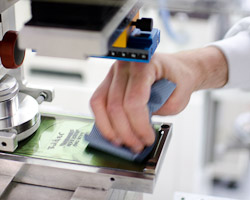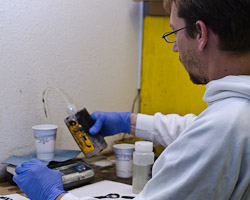Troubleshooting Guide for Pad Printing
Issue: Pad doesn't take up ink
Ink:
| Possible Source |
Possible Solution |
| Ink too thick |
Thin the ink |
| Dried ink on plate |
Clean plate |
| Wrong thinner |
Use correct thinner |
|
Pad:
| Possible Source |
Possible Solution |
| Pad too flat |
Use pad with steep point |
| Pad damaged |
Replace pad |
| Pad worn |
Replace pad |
|
Plate:
| Possible Source |
Possible Solution |
| Depth too shallow |
Use deeper plate |
| Plate damaged |
Make new plate |
| Plate worn |
Make new plate |
|
Other sources:
| Possible Source |
Possible Solution |
| Pad stroke too fast |
Use slower pad stroke |
|
Issue: Pad doesn't release ink
Ink:
| Possible Source |
Possible Solution |
| Ink dried on pad |
Use slower thinner |
| Ink too "wet" at pad |
Use faster thinner |
|
Pad:
| Possible Source |
Possible Solution |
| Pad too flat |
Use pad with steep point |
| Pad damaged |
Replace pad |
| Pad worn |
Replace pad |
|
Plate:
| Possible Source |
Possible Solution |
| Depth too shallow |
Etch image deeper |
| Etch too deep |
Use shallower plate |
|
Other sources:
| Possible Source |
Possible Solution |
| Substrate dirty |
Clean substrate |
| Cycle too slow |
Increase printing speed |
| Room temperature too high |
Set room temperature to 64 to 75° F |
|
Issue: Ink doesn't adhere to substrate
Ink:
| Possible Source |
Possible Solution |
| Wrong ink |
Use recommended ink |
| Wrong hardener |
Use recommended hardener |
|
Pad:
| Possible Source |
Possible Solution |
| Pad weeping silicone oil |
Use pad cleaner |
|
Other sources:
| Possible Source |
Possible Solution |
| Substrate dirty |
Clean substrate |
|
|
Issue: Uneven print quality
Ink:
| Possible Source |
Possible Solution |
| Ink too thin |
Adjust to higher viscosity |
| Color shade too transparent |
Use more opaque ink |
|
Pad:
| Possible Source |
Possible Solution |
| Pad too flat |
Use steeper pad |
| Pad too soft |
Use harder pad |
| Surface too rough |
Replace pad |
|
Plate:
| Possible Source |
Possible Solution |
| Etch too shallow |
Etch image deeper |
|
|
Issue: Ink splashes on substrate
Ink:
| Possible Source |
Possible Solution |
| Ink too thick |
Thin the ink |
| Build up on pad |
Use different thinner |
|
Pad:
| Possible Source |
Possible Solution |
| Pad too flat |
Use steeper pad |
| Surface too rough |
Replace pad |
|
Plate:
| Possible Source |
Possible Solution |
| Etch too deep |
Etch image shallower |
|
Other sources:
| Possible Source |
Possible Solution |
| Static discharge on substrate |
Ionize surface |
| Low humidity |
Set room humidity |
| Printing speed too fast |
Slower printing speed |
|
Issue: Distorted printed image
Pad:
| Possible Source |
Possible Solution |
| Wrong form |
Use different form |
| Wrong hardness |
Use harder pad |
| Pressure too high |
Use less pressure |
| Pressure on plate and substrate not equal |
Use equal pressure on plate and substrate |
| Pad hits on contour of part |
Use other touchdown point |
|
|
Issue: Insufficient opacity
Ink:
| Possible Source |
Possible Solution |
| Ink film too thin |
Adjust color |
| Color too transparent |
Use more opaque ink |
| Insufficient ink transfer |
Check plate and pad |
|
Pad:
| Possible Source |
Possible Solution |
| Pad too flat |
Use steeper pad |
| Pad too soft |
Use harder pad |
| Surface too rough |
Replace pad |
|
Plate:
| Possible Source |
Possible Solution |
| Shallow etch |
Etch image deeper |
| No tint screen |
Use a tint screen |
|
Other sources:
| Possible Source |
Possible Solution |
| Substrate dirty |
Clean substrate |
|
Issue: Color doesn't match
Ink:
| Possible Source |
Possible Solution |
| Ink too thin |
Adjust color |
| Color too transparent |
Use more opaque ink |
| Wrong formula |
Use correct formula |
|
Pad:
| Possible Source |
Possible Solution |
| Incorrect shape |
Use different pad shape |
| Surface too rough |
Replace pad |
|
Return to the Pad Printing Guide or Screen Printing Guide


